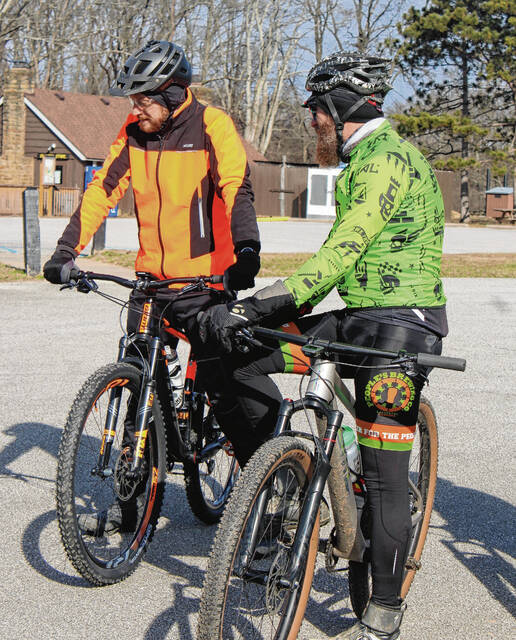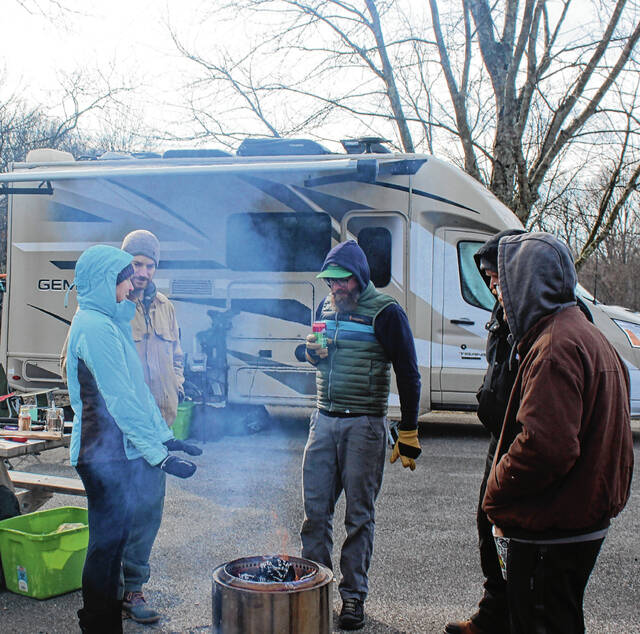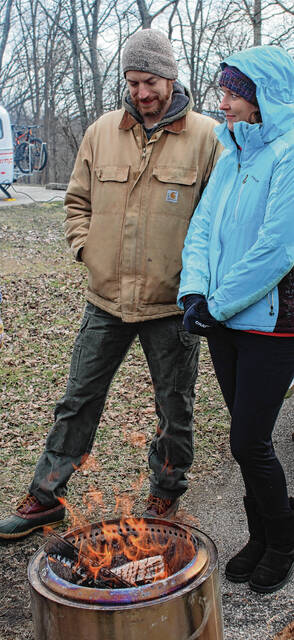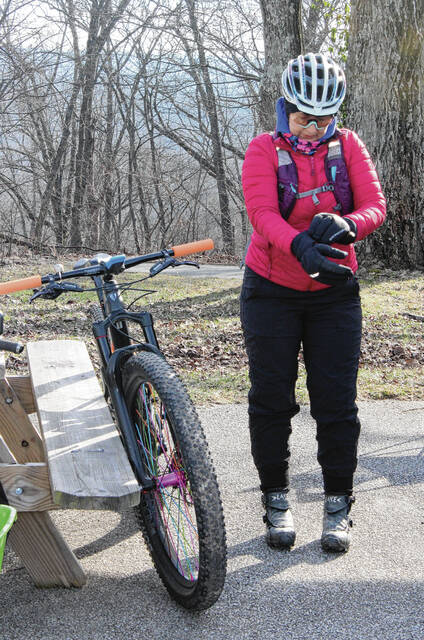NASHVILLE — They surrounded the fire, all bundled up in layers anyway, trying to deflect the cold.
They weren’t cooking, but warding off shivering.
The group of 10 Indiana friends in their 30s and 40s had the campground inside Brown County State Park to themselves. Their cars and RVs were the only ones in the otherwise vast, empty parking lot.
It was a January Saturday morning, so the population count was not unexpected. On a Saturday in July, the area would have been densely packed with vehicles and other campers.
Not so in winter. Winter camping is a different animal, whether RV protected or even bolder, sleeping in a tent on the ground, though those hardy souls are in a distinct minority.
For any outdoor lover flirting with a winter sleepover, Ginger Murphy has an overriding piece of advice. The Indiana Department of Natural Resources deputy director for stewardship said, “My suggestion to people would be to try it and dress warm.”
And light a fire.
Whether it is fishing versus ice fishing, camping indoors versus outdoors, the huge majority of the outdoor-activity-prone prefer warmth over cold. Their minds and bodies associate winter action with frostbite, not fun. But then there are the undaunted.
It was 21 degrees at the Brown County camp, and Jeff Bushong kept placing chunks of wood on two simmering fires giving off smoke and some warmth for he and his friends, mostly from Crawfordsville and Battleground.
“We camp year-round,” he said.
The gang had eaten bacon and eggs already and after standing around talking would head out for mountain bike riding on the trails. This was no special occasion, just a regular outing.
The temperature hardened the trails, freezing mud, so the route would be more reliable. Of course, traveling 15 mph on a bike, the riders would be creating their own wind-chill factor even as they worked up a sweat. Clothing needed to be warm and just right.
Too bad Gen. George Washington and his men didn’t have the proper attire at Valley Forge.
Valley Forge not as much fun
When it comes to winter camping, it is possible Washington and his Continental Army engaged in the most famous and enduring winter camping trip of all-time.
These days, Valley Forge National Historical Park in Pennsylvania is a remnant site of the Revolutionary War and the campout was under orders, keeping a watchful eye on the British occupying Philadelphia, not scheduled as a two-day weekend for kicks.
The reason why the soldiers were cloistered in these makeshift freezing quarters over the winter of 1777-78 was because many citizens had fled Philadelphia and boarded with other residents in a wide perimeter, swallowing up all of the extra rooms in private homes.
No RVs or heavy-duty sleeping bags protected these guys. Washington wrote a note to the Continental Congress that his men “slept under canopies of frost and snow.”
Washington, who experienced his 46th birthday at Valley Forge over that long winter, presided over many thousand freezing soldiers in difficult circumstances. They endured with clothes in tatters and short of food, and at another point, Washington said the army might “starve, dissolve or disperse.”
Hunger was acute. Smallpox was another threat. Many perished.
Even in summer, the remaining buildings on the grounds at Valley Forge do not appear comfortable, not nearly so much as a modern-day RV. When a ranger was asked if someone could camp out on the grounds in winter today, the answer was a flat no.
More want to give it a go
The coronavirus pandemic has been good for camping. RV sales have increased over the last couple of years because people are interested in self-contained, socially distanced vacations.
Indiana state campsites are wildly popular in summer, and obtaining weekend reservations can be its own competitive sport the demand is so high. Not so much in winter.
Steve Hollow State Recreation Area in Vallonia is one of those places.
“We don’t have any reservations in January or February,” said Cassie Stillwell, deputy asset director, as she checked paperwork.
That doesn’t mean no one ever shows up to camp in winter. They are walk-ins who can decide on short notice. On a recent Saturday, however, there were no RVs or people at the Starve Hollow campsite.
Murphy said state properties are open for visitors in winter, and anecdotally, not statistically, she detects an increase in inquiries about winter camping access. For the most part, those who camp at Indiana sites in winter choose parks where there are heated restrooms and available electricity.
But the majority are in campers, Murphy said, campers that may have been winterized to a degree.
“I think people have campers and are interested in using them, and they see other people doing it,” she said.
Plenty of people ride mountain bikes or hike in winter, but mostly, they only come to a park for the day, not to stay over, Murphy said.
“We don’t close,” she said. “Many people say, ‘I’m only going to go in the summer,’ but September, October, our shoulder season, is growing.”
There are also cabins and inns at state sites where people can rent places for the night.
And yes, some people are willing to camp out on the ground in winter.
“We have some individuals who do that,” she said.
Some years ago, Murphy said, she was one of them, doing an overnight at Hardy Lake near Austin.
“I’m tough,” she said. “At least I was tough.” Her overriding memory of the night is, “It was very, very cold.”
Probably not as cold as Valley Forge. Still, it would be worthwhile to winter camp there.
“Hey, who wouldn’t have wanted to hang out with George Washington?” Murphy said.
An adventurer
Lonnie Dupre probably wouldn’t have minded doing that.
An adventurer from Minnesota, Dupre and a partner completed the first circumnavigation of Greenland by dog team and kayak in 2002. He has participated in numerous winter challenges, including climbing 20,320-foot Mount Denali in Alaska in winter, and tried to shed light on global warming issues.
One weekend in 2004, Dupre took a training mission with a partner and invited along a group of couples, seven people in all, traveling on snowshoes or skijoring in the Boundary Waters Canoe Area Wilderness in northern Minnesota.
Trekking across frozen Clearwater Lake, Dupre and his partner transported everyone’s gear to simulate the weight they would pull on a later journey, food, camping equipment and the like. The destination was a campsite to erect tents on hard ground next to a wood stove with others sleeping in smaller tents nearby.
As a large pot of turkey soup simmered, a Dupre friend said he once camped out in Ontario at minus-50. It was only around freezing for this trip. Then it began snowing and the wind picked up.
Talk focused on stories about famed Arctic and Antarctic explorers who had lived through extremes. The ground made for a hard sleep surface, creating aching back muscles and stiffness.
No other people were seen. Snowshoeing across the hard ice induced the lake to creak and groan. It did not crack and open, but almost seemed to be making conversation.
One member of the party said he had never had a bad winter camping trip. No one on this one froze fingers or toes.
Never too cold to bike
Temperatures such as those regularly encountered by explorers like Knud Rasmussen and Vilhjalmur Stefansson are rare in Indiana, but Seth Aichinger of Battleground does not sound as if he would be intimidated.
Aichinger, one of the Brown County group, said he and another gaggle of friends each year plan a winter camping excursion sleeping on the ground. One fellow’s family owns land in Putnam County, and they do the winter camping the hard way.
“No tent,” he said. “A warm sleeping bag. Once a year, we’ve been doing it for about 10 years. It’s fun every time.” Why? “To prove that you’re manly enough to sleep outside.”
“It’s a guy thing,” Aichinger’s wife, Jill, said.
Are any special provisions required?
“Bourbon,” Seth said.
It was not clear if that was an essential ingredient to making the Brown County visit a success, but there was some teasing of Kiel Lester, who slept in his car the night before.
“Good sleeping bag,” he said, indicating he wasn’t really all that chilled despite the razzing over whether he was tougher or dumber than the others. “Not too bad. My feet were a little cold.”
It wouldn’t be winter if toes didn’t get cold.
As the fires diminished, one by one, the friends retreated to vehicles to change clothing. Then as the sun peeked out from the clouds, they climbed aboard their mountain bikes for a miles-long ride.
They hoped when they returned the wood would still be smoking. The fires — and winter— were probably the only things they had in common with the Continental Army.









